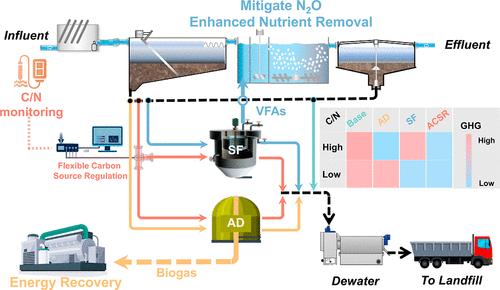Flexible Carbon Source Regulation for Mitigating Greenhouse Gas Emissions in Full-Scale Wastewater Treatment
IF 11.3
1区 环境科学与生态学
Q1 ENGINEERING, ENVIRONMENTAL
引用次数: 0
Abstract
Achieving carbon neutrality in wastewater treatment plants (WWTPs) by 2060 requires effective strategies to mitigate greenhouse gas (GHG) emissions. This study explores the potential of flexible carbon source regulation to reduce GHG emissions while improving the nutrient removal efficiency under varying influent conditions. A plant-wide model was developed, calibrated with one year of hourly monitoring data, to quantify GHG emissions in a full-scale WWTP. We evaluated three carbon regulation strategies: anaerobic digestion (AD), short fermentation (SF), and adaptive carbon source regulation (ACSR). Results show that AD was most effective in high carbon-to-nitrogen (C/N) ratios, reducing GHG emissions by 29.2%. SF performed best at low C/N ratios, reducing N2O emissions by 56.3%. The ACSR strategy, which dynamically adjusts between AD and SF based on influent C/N, achieved a total GHG reduction of 18.2% compared with the base strategy (conventional activated sludge process with mechanical dewatering and landfill disposal of waste sludge). Seasonal variations significantly impacted emissions (p < 0.001), while C/N ratios, although not statistically significant in isolation, play a crucial role in influencing N2O emissions and sludge production, emphasizing the need for adaptive carbon allocation. This study underscores the viability of plant-wide, data-driven carbon source regulation as an integrated approach to achieving net-zero emissions in WWTPs, effectively addressing diverse GHG emission sources within the system.

灵活的碳源法规在全面污水处理中减少温室气体排放
到2060年实现污水处理厂(WWTPs)的碳中和需要有效的战略来减少温室气体(GHG)排放。本研究探讨了灵活的碳源调控在不同进水条件下减少温室气体排放的同时提高营养物去除效率的潜力。开发了一个全厂范围的模型,并用一年的每小时监测数据进行校准,以量化全规模污水处理厂的温室气体排放。我们评估了三种碳调节策略:厌氧消化(AD)、短发酵(SF)和适应性碳源调节(ACSR)。结果表明,AD在碳氮比高的情况下最有效,可减少29.2%的温室气体排放。SF在低碳氮比下表现最佳,N2O排放量减少56.3%。ACSR策略根据进水C/N在AD和SF之间动态调整,与基本策略(传统活性污泥工艺与机械脱水和废污泥填埋处理)相比,总温室气体排放量减少了18.2%。季节变化显著影响排放(p <;0.001),而C/N比率虽然单独没有统计学意义,但在影响N2O排放和污泥产生方面发挥了关键作用,这强调了适应性碳分配的必要性。本研究强调了工厂范围内,数据驱动的碳源监管作为实现污水处理厂净零排放的综合方法的可行性,有效地解决了系统内各种温室气体排放源的问题。
本文章由计算机程序翻译,如有差异,请以英文原文为准。
求助全文
约1分钟内获得全文
求助全文
来源期刊

环境科学与技术
环境科学-工程:环境
CiteScore
17.50
自引率
9.60%
发文量
12359
审稿时长
2.8 months
期刊介绍:
Environmental Science & Technology (ES&T) is a co-sponsored academic and technical magazine by the Hubei Provincial Environmental Protection Bureau and the Hubei Provincial Academy of Environmental Sciences.
Environmental Science & Technology (ES&T) holds the status of Chinese core journals, scientific papers source journals of China, Chinese Science Citation Database source journals, and Chinese Academic Journal Comprehensive Evaluation Database source journals. This publication focuses on the academic field of environmental protection, featuring articles related to environmental protection and technical advancements.
 求助内容:
求助内容: 应助结果提醒方式:
应助结果提醒方式:


